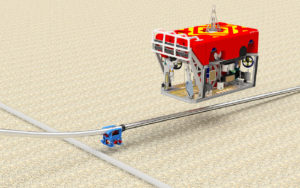Subsea Pipe Crossing
Subsea Pipe Crossings match any pipe size, bare and coated. A common central Pivot Pin provides a common interface between all sizes, bare or coated. Additionally the Pivot Pin allows the unit to swivel to match the angle of the pipelines. Thus the operator can mix and match the two halves of the Pipe Crossing to match any pipeline combination. A size is set to handle coating thickness up to 2% of the diameter of the pipe. Thus for thicker coatings, use the next larger size adjusted to fit by thicker rollers
SUBSEA PIPE CROSSING
Click on image for more information
SUBSEA PIPE CROSSING PROVIDES PERMANENT SEPARATION FOR SUBSEA PIPELINES
LOCKS ONTO 2 CROSSING PIPELINES
PROVIDES ROLLERS FOR FREE MOVEMENT OF PIPELINES
INSULATES BETWEEN PIPELINES
PROVIDES DESIGNATED SHEARING FORCE
ELIMINATES REPETITIVE SANDBAGGING
CAN MIX AND MATCH SIZES (I.E. 10” X 6”)



